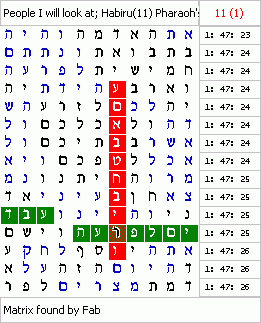
Code by Fab
Pharaoh's slaves - People I will look at; Habiru.



A code
inspired by a recent discussion and using the term "Habiru"
and found in the Torah. Most modern scholars, based on their own interpretation
of the archeological data, assert that there is no evidence that
there were Hebrew slaves in Egypt. There is some discussion on
the exact meaning of the term "Habiru" found on many ancient records.
The second shortest skip of this term is found very close to the expression
"Pharaoh's slaves" in the surface text and was extendable
to "people I will watch at; Habiru":
http://en.wikipedia.org/wiki/Habiru#Habiru_and_the_Hebrew
What about evidence of Jewish slavery?
Egyptologist Sir Alan Gardiner said of Egyptian archaeology: "It must never be forgotten that we are dealing with a civilization thousands of years old and one of which only tiny remnants have survived. What is proudly advertised as Egyptian history is merely a collection of rags and tatters."
This sketchy archaeological record makes a document preserved from the Israelite slavery period even more astounding. Known as the Brooklyn Papyrus (because it is in the Brooklyn Museum), this document portrays Israelite names from the Bible as the names of domestic slaves: Asher, Yissachar, and Shifra. The document also includes the term "hapiru" which many scholars agree has clear historical affinity to the biblical term "ivrim," meaning "Hebrews."
The Bible records that Jews built the storage cities of Pitom and Ramses. Austrian archaeologist Manfred Bietak has succeeded in positively identifying the city of Pi-Ramesse. This city he found dates exactly to the period of the sojourn in Egypt, and even contains many Asiatic (of Canaanite origin) remains at the area of the slave residences.
Egyptian records also tell how Pharaoh Rameses II built a new capital called Pi-Ramesse (the House of Rameses) on the eastern Nile delta, near the ancient area known as Goshen, the precise geographic area where the Bible places the Israelites.
Further, the Leiden Papyrus (another Egyptian document of that era) reports that an official for the construction of Ramasses II ordered to "distribute grain rations to the soldiers and to the Apiru who transport stones to the great pylon of Ramasses." (Apiru, as we said, is related to Hebrews.)
Professor
Abraham Malamat of Hebrew University infers from this that the Hebrews
were forced to build the city of Ramasses. "This evidence is
circumstantial at best," notes Malamat, "but it's as much as a historian
can argue."